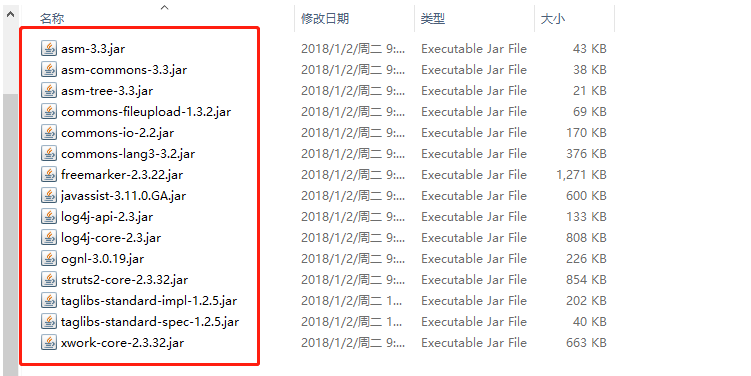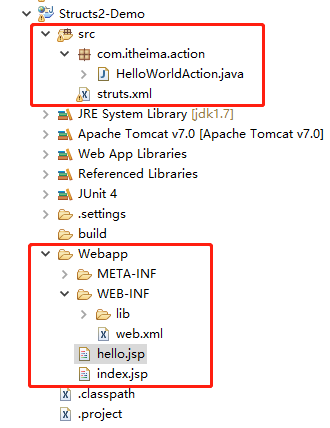更新時間:2018-07-27 來源:黑馬程序員 瀏覽量:
一、struts2 概述
Struts2 是一種基于 MVC (表現層、業務層、持久層)模式的輕量級 Web 框架,它自問世以來,就受到了廣大 Web 開發者的 關注,并廣泛應用于各種企業系統的開發中
二、struts2 的入門案例
第一步:拷貝 struts2 必備 jar 包到 web 工程的 lib 目錄
第二步:在類的根路徑下創建一個名稱為 struts.xml 的文件,并導入約束和配置(詳細如下)
<?xml version="1.0" encoding="UTF-8"?>
<!-- 導入約束:
約束的位置:在 struts2 的核心 jar 包中
struts2-core-2.3.24.jar 中包含一個名稱為:
struts-2.3.dtd 的約束文件
-->
<!DOCTYPE struts PUBLIC "-//Apache Software Foundation//DTD Struts Configuration 2.3//EN"
"struts-2.3.dtd" >
<struts>
<!-- 請求路徑和執行方法的關系
package標簽:主要的作用是用于分模塊
name:唯一標識符,同一個項目,package的名字不可以相同
extends:繼承,基于繼承其他包的功能。struts-default是框架內置的package。
如果不繼承會導致,內置的功能組件不能使用
-->
<package name="default" extends="struts-default">
<!--
action標簽:請求路徑和執行方法的關系
name:用于指定請求路徑(url)
class:指定業務控制器的類名
method:指定執行的方法
-->
<action name="hello_say" class="com.itheima.action.HelloWorldAction" method="say">
<!-- 視圖映射字符串和視圖路徑的關系 -->
<!--
result:用于配置返回
name:指定視圖對應的映射字符串
標簽內容:視圖路徑
-->
<result name="hello">/hello.jsp</result>
</action>
</package>
</struts>
第三步:在 web.xml 配置 struts2 的核心控制器(一個過濾器)
<?xml version="1.0" encoding="UTF-8"?>
<web-app xmlns:xsi="http://www.w3.org/2001/XMLSchema-instance" xmlns="http://java.sun.com/xml/ns/javaee" xsi:schemaLocation="http://java.sun.com/xml/ns/javaee http://java.sun.com/xml/ns/javaee/web-app_3_0.xsd" id="WebApp_ID" version="3.0">
<display-name>crm-annotation</display-name>
<!-- 配置 struts2 的核心控制器:一個過濾器 -->
<filter>
<filter-name>struts2</filter-name>
<filter-class>org.apache.struts2.dispatcher.ng.filter.StrutsPrepareAndExecuteFilter</filter-class>
</filter>
<filter-mapping>
<filter-name>struts2</filter-name>
<url-pattern>/*</url-pattern>
</filter-mapping>
<welcome-file-list>
<welcome-file>index.html</welcome-file>
<welcome-file>index.htm</welcome-file>
<welcome-file>index.jsp</welcome-file>
<welcome-file>default.html</welcome-file>
<welcome-file>default.htm</welcome-file>
<welcome-file>default.jsp</welcome-file>
</welcome-file-list>
</web-app>
第四步:編寫index.jsp頁面(href是指定請求路徑,和struts.xml的action name一致)
<%@ page language="java" contentType="text/html; charset=UTF-8"
pageEncoding="UTF-8"%>
<!DOCTYPE html PUBLIC "-//W3C//DTD HTML 4.01 Transitional//EN" "http://www.w3.org/TR/html4/loose.dtd">
<html>
<head>
<meta http-equiv="Content-Type" content="text/html; charset=UTF-8">
<title>Insert title here</title>
</head>
<body>
<a href="${pageContext.request.contextPath }/hello_say">say</a>
</body>
</html>
第五步:編寫HelloWorldAction.java文件(類路徑和名、方法名、返回值和Structs.xml配置的一致)
package com.itheima.action;
public class HelloWorldAction {
public String say() {
System.out.println(this);
System.out.println("HelloAction 中的 sayHello 方法執行了。。。。");
return "hello";
}
}
第六步:編寫hello.jsp頁面
<%@ page language="java" contentType="text/html; charset=UTF-8"
pageEncoding="UTF-8"%>
<!DOCTYPE html PUBLIC "-//W3C//DTD HTML 4.01 Transitional//EN" "http://www.w3.org/TR/html4/loose.dtd">
<html>
<head>
<meta http-equiv="Content-Type" content="text/html; charset=UTF-8">
<title>Insert title here</title>
</head>
<body>
你好世界!!
</body>
</html>
項目目錄結構如下:

第七步:把項目部署到Tomcat,啟動Tomcat,訪問index.jsp,點擊say,將返回訪問hello.jsp頁面

作者:黑馬程序員javaEE培訓學院
首發:http://java.itheima.com/